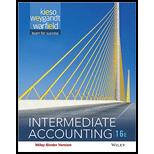
Concept explainers
Acid-test ratio: Acid-test ratio is ability of a company to pay back its immediate liabilities with its short term assets. This ratio can also be called as a
Financial leverage: It is the amount of debt used by an entity to buy assets.
(a) To identify and explain: To identify the contributing factor for this apparently divergent trend using the ratios provided. The current ratio is increasing while the acid-test (quick) ratio is decreasing.
Given information: All the related information is provided in the question document.
(b) To determine: To determine the conclusion can be drawn regarding the company's use of financial leverage during the 2015-2017 periods.
Given information: All the related information is provided in the question document.
(c) To determine: To determine the conclusion can be drawn regarding the company's net investment in plant and equipment.
Given information: All the related information is provided in the question document.
Want to see the full answer?
Check out a sample textbook solution
Chapter 24 Solutions
Bundle: Intermediate Accounting 16e Binder Ready Version + WileyPLUS Access Code
- Tommys so books on leo July 21 year-end. The company does make eerless crue for Inverses ancage de ke year-end. On June 30, 2007, the Recall cours kolonce à 304,400 Now Reclude she folowing Dute Maker Face Value Tar Maturity Data R Apt C 85,000 90 day July 20 May 15 ya 7,000 July24 Car 10,000 December During Julhe following recom July Modes of $4,300 on Toorak edece 165700 un Vrede cord. The cred card recharge la 26. 20 Recall 24 (a) Journalize the July wonde July designery for ccrued in recevable coming 250 days for exams.com of goods sold edit account titles are automatically indented when amo Account Titles and Explanation Date Debit Credit Textbook and Media List of Accountaarrow_forwardBased on the screenshot, what is the shortest path and duration?arrow_forwardBased on the screenshot, what is the maximim flow?arrow_forward
- I want question answer financial accountingarrow_forwardForeign currency remeasurement—Total assets A U.S.-based parent company acquired a European Union–based subsidiary many years ago. The subsidiary is in the service sector, and earns revenues and incurs expenses evenly throughout the year. The following preclosing trial balance includes the subsidiary’s original Euros-based accounting information for the year ended December 31, 2022, immediately prior to closing the company’s nominal accounts into the corresponding balance sheet accounts. It also includes the information converted into $US based on the indicated exchange rates: $US Conversion Weighted- Debits (Credits) Euros Current Average Historical Monetary Assets € 180,000.00 $216,000 $221,400 $234,000 Nonmonetary assets 720,000 864,000 885,600 936,000 Monetary Liabilities (90,000) (108,000) (110,700) (117,000) Nonmonetary liabilities (450,000) (540,000) (553,500) (585,000) Contributed capital (216,000) (259,200) (265,680) (302,400) Retained earnings…arrow_forwardForeign currency remeasurement—Stockholders’ equity A U.S.-based parent company acquired a European Union–based subsidiary many years ago. The subsidiary is in the service sector, and earns revenues and incurs expenses evenly throughout the year. The following preclosing trial balance includes the subsidiary’s original Euros-based accounting information for the year ended December 31, 2022, immediately prior to closing the company’s nominal accounts into the corresponding balance sheet accounts. It also includes the information converted into $US based on the indicated exchange rates: $US Conversion Weighted- Debits (Credits) Euros Current Average Historical Monetary Assets € 160,000.00 $192,000 $196,800 $208,000 Nonmonetary assets 640,000 768,000 787,200 832,000 Monetary Liabilities (80,000) (96,000) (98,400) (104,000) Nonmonetary liabilities (400,000) (480,000) (492,000) (520,000) Contributed capital (192,000) (230,400) (236,160) (268,800) Retained…arrow_forward
- ? ? Financial accounting questionarrow_forwardThe income statement of a merchandising company includes Cost of Goods Sold (COGS) and gross profit, which are not found on a service company’s income statement. This is because merchandising companies sell physical products, while service companies provide intangible services. Service company income statements are simpler, usually showing revenue from services minus operating expenses like salaries, rent, and supplies. In short, the main difference is that merchandising firms track product costs and gross profit, while service companies do not. Respond to this post. agree or disagreearrow_forwardPlease give me true answer this financial accounting questionarrow_forward

 AccountingAccountingISBN:9781337272094Author:WARREN, Carl S., Reeve, James M., Duchac, Jonathan E.Publisher:Cengage Learning,
AccountingAccountingISBN:9781337272094Author:WARREN, Carl S., Reeve, James M., Duchac, Jonathan E.Publisher:Cengage Learning, Accounting Information SystemsAccountingISBN:9781337619202Author:Hall, James A.Publisher:Cengage Learning,
Accounting Information SystemsAccountingISBN:9781337619202Author:Hall, James A.Publisher:Cengage Learning, Horngren's Cost Accounting: A Managerial Emphasis...AccountingISBN:9780134475585Author:Srikant M. Datar, Madhav V. RajanPublisher:PEARSON
Horngren's Cost Accounting: A Managerial Emphasis...AccountingISBN:9780134475585Author:Srikant M. Datar, Madhav V. RajanPublisher:PEARSON Intermediate AccountingAccountingISBN:9781259722660Author:J. David Spiceland, Mark W. Nelson, Wayne M ThomasPublisher:McGraw-Hill Education
Intermediate AccountingAccountingISBN:9781259722660Author:J. David Spiceland, Mark W. Nelson, Wayne M ThomasPublisher:McGraw-Hill Education Financial and Managerial AccountingAccountingISBN:9781259726705Author:John J Wild, Ken W. Shaw, Barbara Chiappetta Fundamental Accounting PrinciplesPublisher:McGraw-Hill Education
Financial and Managerial AccountingAccountingISBN:9781259726705Author:John J Wild, Ken W. Shaw, Barbara Chiappetta Fundamental Accounting PrinciplesPublisher:McGraw-Hill Education





